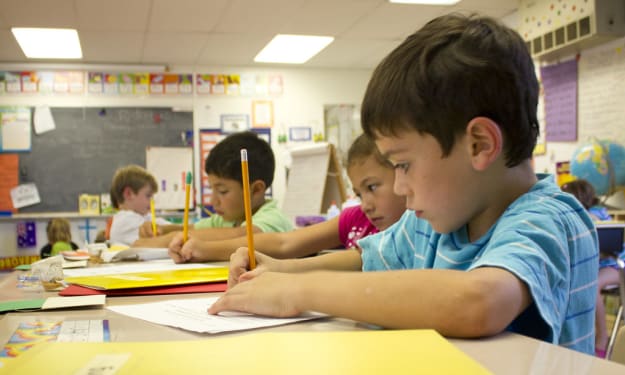The High Cost of Homework
Is It Worth It?

As a future teacher, I want to understand the cognitive, physical, and social toll certain practices have on our students. Homework is a central part of school, at least that’s what we have been led to believe, but young children may suffer unjustifiably in the name of academic success. Particularly during the elementary school years, the young bodies and minds of children under the age of about 10 are not yet equipped developmentally for the sometimes daunting demands of homework. This is the age group I hope to teach someday. Homework has many effects, specifically because it is developmentally inappropriate, it wastes valuable time that could be used for other cognitive and social development, and it produces an educational gap.
Homework Is Developmentally Inappropriate
The psychologist Lev Vygotsky believed that challenging tasks for children promote maximum cognitive growth. Called the zone of proximal development, it was described as “the range of tasks that children cannot yet perform independently, but can perform with the help and guidance of others” (Cognitive Development: Piaget and Vygotsky, pg. 218). This independent homework becomes a task that the child is expected to successfully accomplish without assistance and thus provides little cognitive benefit. Some parents also admit to even completing most of their child’s homework for them just to get it done, which provides as much benefit to the student as working independently. According to the NEA article Research Spotlight on Homework, students should only spend about 10 minutes a night on homework per grade; 10 minutes for first grade, 20 minutes for second grade, etc. (Research Spotlight on Homework). Vygotsky acknowledged “that brain maturation places limits on what children can do at various points in development,” and some children may not be developmentally ready for the increasing loads of homework (pg. 231). Kelly Wallace of CNN finds that students are now spending a staggering three times as much time on homework than the recommendation (Wallace). This produces a waste of valuable time, which could be spent elsewhere.
Homework Wastes Students’ Valuable Time
With so much time spent doing homework, students are not given enough time for more enriching activities. Group activities and play provides an educational environment while also acknowledging children’s playful nature. Jean Piaget and Vygotsky both believed that play is not just about fun, but “provides an arena in which youngsters can practice skills they will need in later life” (Cognitive Development: Piaget and Vygotsky, pg. 220). Through games, children learn valuable social skills and rules that allow them to cooperate, problem-solve, and plan ahead. According to the psychologists, “play, then, is hardly a waste of time” (pg. 221). Children already spend much of their day at school, and should be free to explore other activities once the school day is over. “A reasonable alternative [to homework] is authentic activities – classroom tasks and projects that closely resemble typical adult activities” (pg. 228). These are the kinds of assignments I hope to incorporate into my own classroom and teaching philosophy. It is much more natural for children to engage in this type of self-motivated learning, because children are inherently curious. As the psychologist Piaget explained, “growing children are naturally inclined to try to make sense of the people, objects, and events around them” (pg. 196). When we don’t allow them adequate time to explore on their own, students can be become uninterested and unmotivated. It’s been shown that children “read more energetically and persistently, use more sophisticated metacognitive strategies, and remember more content when they are interested in what they are reading” (Development In the Academic Domains, pg. 380). However, some students have more of an advantage in the experiences and resources available to them.
Homework Produces an Educational Gap
Every student is a unique individual, bringing to the classroom their own culture, customs, and beliefs. This can leave some students with more of an advantage than others. Homework is not always appropriate during the elementary school years because, depending on a child’s living situation and environment, it can create an educational gap. Younger children are especially influenced by their community and family, and may not be able to overcome obstacles until they reach a certain age. Students from low-income families aren’t always adequately prepared for the academic demands of school, as they do not regularly engage in advanced dialog, receive much encouragement, or have the same resources available to other students (Family, Culture, and Community, pg. 104). Teachers sometimes assume that students “have had certain kinds of experiences before they begin school…However, some children who live in extreme poverty miss out on these foundational experiences” (pg. 105). When this occurs, students can feel unrepresented and uninterested in the curriculum, leading to a lack of understanding. Many students have diverse family structures, as well, and may not be appropriately encouraged at home. Busy, single parents or a crowded house can cause some students to neglect homework, and they fall further behind in the class. Getting to know our students, their families, and their community will help us understand their unique needs. “With a little creativity, teachers can easily broaden activities so that they accommodate diverse family structures” (pg. 78).
CONCLUSION
Consequently, homework has been shown to be too high a cost for our students to pay. It wastes valuable time during their most crucial developmental periods that could be used for cognitive and social growth. The readiness and background of some students may prevent them from fully understanding the work, which more often than not isn’t relevant to their life experiences. Differences in socioeconomic status, beliefs, and individual families may put some students at a disadvantage in classrooms without an emphasis on multiculturalism. As teachers, it is our job to make sure our students are represented and acknowledged, and throughout my career I hope to continue researching this topic. Opinions from real teachers and students would help piece together the true cost of homework. Every child is unique, and if given the chance, contributes valuable knowledge to the classroom. To fully assess and understand our students’ progress means discarding the biased structure of homework, looking beyond labels and ranks, and helping students cultivate their full potential.
Works Cited
McDevitt, Teresa M., and Jeanne Ellis. Ormrod. Child Development and Education. Pearson; 5th Edition, 2012. Print.
“Research Spotlight on Homework.” National Education Association: Great Public Schools for Every Student. Web. 01 May 2016.
Wallace, Kelly. "Kids Have Three Times Too Much Homework, Study Finds; What’s the Cost?" CNN. Cable News Network, 12 Aug. 2015. Web. 01 May 2016.
If you enjoyed this article, please feel free to leave a tip. Anything can help as I try to deliver all kinds of interesting content to readers. Please consider reading some of my other works, and I thank you so much for the support!
About the Creator
Kayla Bloom
Just a writer, teacher, sister, and woman taking things one day at a time in a fast-paced world. Don’t forget to live your dreams.






Comments
There are no comments for this story
Be the first to respond and start the conversation.